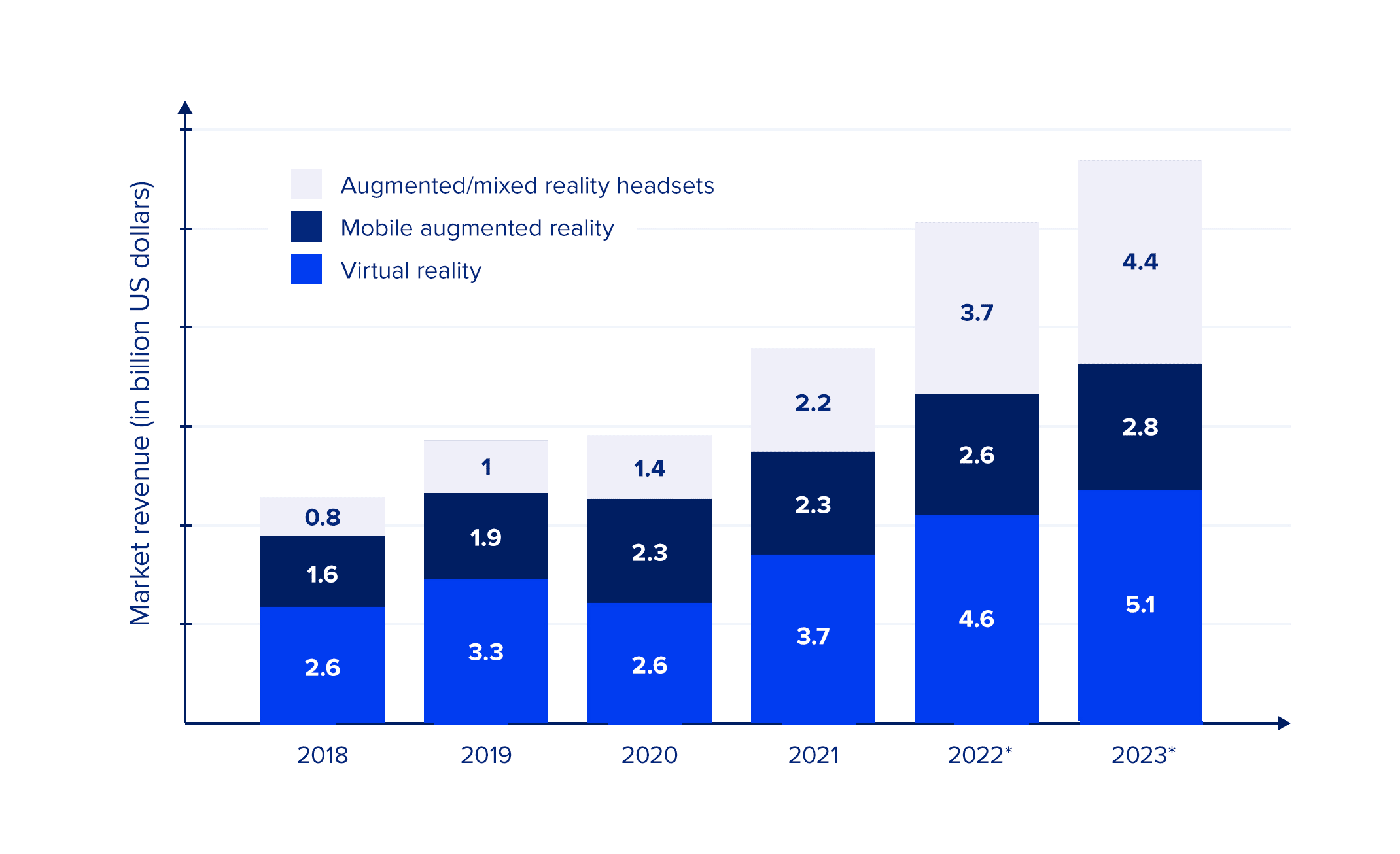
For many businesses, going digital is the only way to maintain a connection with customers and continue to carry out operations in an increasingly tech-driven world. According to Statista, global spending on enterprise software totalled $426 billion this year and is expected to grow by 7.2%, to $492 billion, in 2021.
To stay ahead of the market, simply adopting current technologies to ERP software solutions isn't enough. To keep pace and, indeed, outrun the competition, you need to have your eye on the ball when it comes to the most cutting-edge emerging tech. Here's our rundown of the eight software development trends that are likely to dominate the tech industry in 2021 and beyond.

1. The rise of the Intelligence of Things (IoT)
According to Statista, consumer spending on smart home systems increased to $103 billion in 2019. Smart homes and assistants have already permeated our daily routine and, now, the focus is shifting towards a more globally prevalent Internet of Things.
Artificial intelligence has become a key component of most of our standalone devices. It has become indispensable to daily life and it's this indispensability that's predicted to shift the landscape: from the Internet of Things to the Intelligence of Things. This abundance of new-generation smart devices will disrupt a plethora of industries – from automotive through to agriculture.
Here are just a few examples of IoT's many use cases:
- Connected vehicles. Applied as a part of automotive software engineering services, IoT is integral to a connected car, offering numerous benefits such as in-car payments, autonomous driving, booking dinner reservations on the move and enabling remote software updates, etc.
- Enhancing the experience of distant education. Tablets, laptops and even smartphones are among the many connected devices that are helping to safeguard educational processes in the era of social distancing – and beyond.
- Assets and equipment management. Real-time tracking, powered by IoT sensors, can improve efficiency and transparency throughout the entire management process in industries like logistics and delivery, automotive, and others.
- Predictive analytics. Connected devices can be utilised as a part of energy software development or applied in manufacturing to analyse the condition of equipment and ward off any potential issues.
- Remote healthcare. Smartwatches and other IoT-enabled devices can be used to track a patient's health and send alerts to their doctor in the event of deterioration. The records obtained from these devices can also be used to assist doctors during the treatment process.

There are myriad other IoT applications and they will all come to play an increasingly significant role in everyday life. For every software development company, the ability to deliver code for energy-efficient IoT devices will remain a vital skill. However, for IoT to reach its full potential, it needs to be combined with artificial intelligence (AI) and big data.
2. Artificial Intelligence is here to stay
Artificial intelligence is an evolving branch of computer science which analyses a vast amount of data and performs human-like tasks, based on its outcomes. Machine learning, deep learning, and natural language processing are among AI's many capabilities – which can be deployed at scale across a business.
The International Data Corporation estimates the global AI market will reach $156.5 billion by the end of 2020. And AI isn't just a software development trend: it's become a game-changing force within the current technological landscape.
AI has enabled the development and deployment of advanced and highly tailored solutions throughout multiple industries including retail, healthcare, finance, logistics, and more. Businesses will continue to adopt AI as one of the top software development trends, over the next few years, in a bid to offer their customers/users a more personalised experience, to streamline their operations, boost productivity and much, much more.
3. The rise of progressive and hybrid apps
Progressive web applications (PWAs) are a combination of a web page and mobile app. Similar to native apps, PWAs can work offline and send push notifications. But unlike native apps, PWAs are linkable, can be used across platforms (no separate codebases needed for Android and iOS) and don't require any involvement from app stores.
Hybrid application development also covers elements of native and web apps. Using a particular framework, hybrid apps are created by adding features of both native and web applications. According to Statista, in 2020 the framework most widely adopted by global developers was React Native (42%). Other common cross-platform mobile frameworks include Flutter, Cordova, Ionic and Xamarin.
Twitter, Forbes and AliExpress are among the many leading companies to have already adopted PWA solutions for their multiple benefits. And, after Pinterest introduced PWA, its core engagement rose by 60% and the time users spent on site, by 40%.
PWAs are lightweight (often up to 1MB), load fast and are detectable by search engines. HTTPS protocols can ensure a more secure PWA connection. With their ability to adapt to different screen sizes and share an app's URL, their reduced build time and costs and their potential to offer even more benefits than mobile, PWAs look set to be one of the dominant web software development trends in 2021.

4. Cybersecurity is more critical than ever
In 2020, the global cost of data breaches has reached $3.86 million. Add to that the ongoing pandemic and the digital shift it has expedited and cybercriminals are only gaining more and more opportunities to stage a novel attack. Robust security measures can prevent fraud, information leaks, malware, ransomware, phishing and other cyberattacks from ever occurring, by looking for chinks in an organisation's IT armour.
45% of companies with full security integration can fix critical vulnerabilities within a day. Integrating security solutions like hashing protocols, machine learning algorithms for fraud detection and blockchain-based software solutions can mitigate the key security risks and help to guard your organisation against cyberattacks.
5. Immersive experiences gain popularity
A digital reality isn't a brand-new concept and has already carved out its share of the market. But, when the pandemic hit and real-world experiences became scarce, immersive environments were able to replicate the outdoors and attract more consumers. According to a report by Accenture, 61% of respondents now prefer to shop with augmented and virtual reality (AR/VR).
Mixed reality (MR) is a perfect combination of AR, which brings the digital experience to the physical world, and VR, which can create a lifelike immersive experience. MR has a whole host of use cases within a broad range of industries, including:
- Virtual tours and travel. Lockdowns throughout the world have seen museums, zoos, galleries and theme parks shut their doors, while grinding the travel and tourism sectors to a near halt. However, virtual experiences offer consumers the possibility to seek out new places and adventures from the comfort and safety of their homes.
- Simulation-based training. AR and VR technologies create realistic scenarios in a digital environment, which facilitates the training process by enabling learners to practice their skills and understand the consequences of their actions.
- Online shopping. Ecommerce industry players can provide consumers with more interactive experiences, by introducing try-before-you-buy features powered by immersive tech.
6. Introduction of low code platforms
The so-called low code platform is one of the emerging software development trends within the tech industry. The core function of low code development platforms is to enable anyone with an idea and little to no coding experience to write their own software.
Some developers are sceptical of low code platforms because, traditionally, an experienced team of software engineers and architects is required in order to create a robust digital solution. But it seems these disruptive new platforms have the capability to reshape the software market.
For instance, Amazon Honeycode can help streamline the process of creating apps for simple task or event management and Parabola is an automation platform designated to automate processes via an easy-to-use drag-and-drop interface. IT teams can leverage the advantages of low code platforms to speed up the development process and, therefore, give themselves more time to generate innovative ideas.
7. 5G is reinventing the network
5G is among the newest technologies expected to revolutionise the global communications sector. The 5G technology market is expected to amount to $5.53 billion by the close of 2020, increasing to $667.90 billion by 2026.
5G can be described as a technical enabler for IoT and future emerging tech products, since 4G operates at a lower speed and consumes major resources which shorten battery life. 5G, by comparison, is anticipated to offer lower latency, greater bandwidth availability and better data security. Developers will be able to create more powerful apps and users will gain better experiences at a faster speed.
8. Run cost as architecture fitness function
Software development practices like Agile methodologies and DevOps lead to changes in cloud infrastructure and services management. A new "run cost as architecture fitness function" technique was proposed by Thoughtworks in Technology Radar. The method involves continuously monitoring cost as a fitness function ("fitness function" is the automated control of maintaining the non-functional characteristics of a product that's continuously changing).
We advise teams to frame a system's run cost as architecture fitness function, which means: track the cost of running your services against the value delivered; when you see deviations from what was expected or acceptable, have a discussion about whether it's time to evolve your architecture.
Conclusion
2020 and 2021 have brought about disruption to many aspects of daily life and, as a direct result, has accelerated many burgeoning software development trends. Businesses who want to strike out in an increasingly competitive marketplace must adapt to the changing environment and, thus, keep pace with the dynamic software development industry.
Prominent and widely adopted trends determine the leaders of the future market but it's not always obvious where to begin and how to incorporate these innovative technologies. So, you might consider using the expertise of a nearshore technology partner to investigate the pros and cons of technologies and assess their potential within your business environment. You can benefit from a help of a smart development team to quickly scale up your capacity, meet any gap in your skillset and get your product to market faster.
If you want to reap the benefits of emerging technologies and get ahead of the competition, talk to an ELEKS specialist today.
Related Insights












